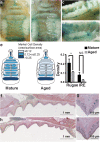Somatosensory innervation of the oral mucosa of adult and aging mice
- PMID: 29967482
- PMCID: PMC6028454
- DOI: 10.1038/s41598-018-28195-2
Somatosensory innervation of the oral mucosa of adult and aging mice
Abstract
Oral mechanoreception is implicated in fundamental functions including speech, food intake and swallowing; yet, the neuroanatomical substrates that encode mechanical stimuli are not well understood. Tactile perception is initiated by intricate mechanosensitive machinery involving dedicated cells and neurons. This signal transduction setup is coupled with the topology and mechanical properties of surrounding epithelium, thereby providing a sensitive and accurate system to detect stress fluctuations from the external environment. We mapped the distribution of anatomically distinct neuronal endings in mouse oral cavity using transgenic reporters, molecular markers and quantitative histomorphometry. We found that the tongue is equipped with an array of putative mechanoreceptors that express the principal mechanosensory channel Piezo2, including end bulbs of Krause innervating individual filiform papillae and a novel class of neuronal fibers innervating the epithelium surrounding taste buds. The hard palate and gums are densely populated with three classes of sensory afferents organized in discrete patterns including Merkel cell-neurite complexes, Meissner's corpuscles and glomerular corpuscles. In aged mice, we find that palatal Merkel cells reduce in number at key time-points that correlate with impaired oral abilities, such as swallowing and mastication. Collectively, this work identifies the mechanosensory architecture of oral tissues involved in feeding.
Conflict of interest statement
Portions of this work were funded by NesTec.
Figures






Similar articles
-
Somatosensory innervation of healthy human oral tissues.J Comp Neurol. 2021 Aug 1;529(11):3046-3061. doi: 10.1002/cne.25148. Epub 2021 Apr 29. J Comp Neurol. 2021. PMID: 33786834 Free PMC article.
-
Ultrastructures of mechanoreceptors in the oral mucosa.Anat Sci Int. 2004 Jun;79(2):55-61. doi: 10.1111/j.1447-073x.2004.00067.x. Anat Sci Int. 2004. PMID: 15218624 Review.
-
Sensory nerve endings in the hard palate and papilla incisiva of the rhesus monkey.Anat Embryol (Berl). 1999 May;199(5):427-37. doi: 10.1007/s004290050241. Anat Embryol (Berl). 1999. PMID: 10221454
-
Merkel cells and Meissner's corpuscles in human digital skin display Piezo2 immunoreactivity.J Anat. 2017 Dec;231(6):978-989. doi: 10.1111/joa.12688. Epub 2017 Sep 14. J Anat. 2017. PMID: 28905996 Free PMC article.
-
Merkel cells and neurons keep in touch.Trends Cell Biol. 2015 Feb;25(2):74-81. doi: 10.1016/j.tcb.2014.10.003. Epub 2014 Dec 2. Trends Cell Biol. 2015. PMID: 25480024 Free PMC article. Review.
Cited by
-
Piezo 1 and Piezo 2 in the Chemosensory Organs of Zebrafish (Danio rerio).Int J Mol Sci. 2024 Jul 5;25(13):7404. doi: 10.3390/ijms25137404. Int J Mol Sci. 2024. PMID: 39000511 Free PMC article.
-
Uncovering the Cells and Circuits of Touch in Normal and Pathological Settings.Neuron. 2018 Oct 24;100(2):349-360. doi: 10.1016/j.neuron.2018.10.019. Neuron. 2018. PMID: 30359601 Free PMC article. Review.
-
Miswiring of Merkel cell and pruriceptive C fiber drives the itch-scratch cycle.Sci Transl Med. 2022 Jul 13;14(653):eabn4819. doi: 10.1126/scitranslmed.abn4819. Epub 2022 Jul 13. Sci Transl Med. 2022. PMID: 35857641 Free PMC article.
-
Neuroimmune interplay during type 2 inflammation: Symptoms, mechanisms, and therapeutic targets in atopic diseases.J Allergy Clin Immunol. 2024 Apr;153(4):879-893. doi: 10.1016/j.jaci.2023.08.017. Epub 2023 Aug 25. J Allergy Clin Immunol. 2024. PMID: 37634890 Free PMC article. Review.
-
Axonal and Glial PIEZO1 and PIEZO2 Immunoreactivity in Human Clitoral Krause's Corpuscles.Int J Mol Sci. 2024 Jun 18;25(12):6722. doi: 10.3390/ijms25126722. Int J Mol Sci. 2024. PMID: 38928429 Free PMC article.
References
Publication types
MeSH terms
Substances
Grants and funding
LinkOut - more resources
Full Text Sources
Other Literature Sources
Medical
Molecular Biology Databases

